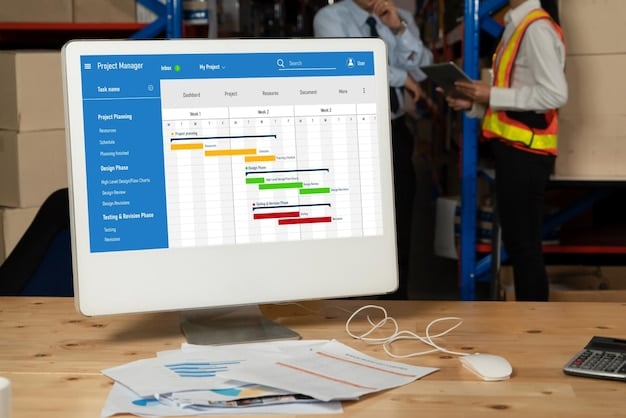Micro-Influencer Marketing: Is It Worth the Investment?

Micro-influencer marketing involves collaborating with influencers who have smaller but highly engaged audiences; its cost-effectiveness and ability to foster authentic connections often make it a valuable investment for brands.
Are you contemplating leveraging social media influencer marketing but unsure where to start? The world of influencers can seem daunting, with mega-influencers dominating headlines. However, the real power might lie in the hands of **social media influencer marketing: are micro-influencers worth the investment?** Let’s delve into the pros, cons, and everything you need to know about micro-influencer marketing to decide if it’s the right strategy for your brand.
Understanding Micro-Influencers
Micro-influencers have emerged as a potent force, reshaping the landscape of digital marketing. These individuals, typically boasting follower counts ranging from 1,000 to 100,000, possess an unparalleled ability to connect with their audience on a personal level.
Their strength lies not in sheer numbers, but in the depth of engagement and the authenticity they exude, setting them apart from traditional celebrity endorsements and mega-influencers. This authenticity drives real results, making them a valuable asset for brands aiming to connect with their target consumers in a genuine and impactful way.
The Rise of Authenticity
In an era where consumers are increasingly skeptical of traditional advertising, authenticity has become a prized commodity. Micro-influencers offer a refreshing departure from the polished, often unattainable images projected by celebrities and mainstream media.
Defining Engagement Rate
Engagement rate is a crucial metric in influencer marketing, measuring the level of interaction an influencer’s content receives from their audience. It is calculated by dividing the total number of engagements (likes, comments, shares) by the number of followers, then multiplying by 100 to get a percentage.
- Higher engagement rates signify that an influencer’s content resonates strongly with their audience, indicating a more authentic and credible connection.
- Micro-influencers often have significantly higher engagement rates compared to mega-influencers.
- A higher engagement rate can translate to better campaign performance, as engaged followers are more likely to trust and act on the influencer’s recommendations.

Micro-influencers are more than just content creators; they are trusted voices within their niche communities. Their followers recognize and respect their opinions, making them powerful advocates for the brands they choose to endorse. This authenticity translates into higher engagement rates and more meaningful connections with potential customers.
Benefits of Partnering with Micro-Influencers
Micro-influencers offer a range of advantages that can significantly enhance your marketing efforts. From cost-effectiveness to hyper-targeted reach, these influencers provide a unique value proposition that sets them apart from other marketing channels.
Their specialized knowledge, genuine engagement, and credible reputation make them an invaluable asset for brands seeking authentic connections with their target audience.
Cost-Effectiveness
One of the most compelling advantages of working with micro-influencers is their affordability when compared to mega-influencers and celebrities. This cost-effectiveness allows businesses, especially smaller ones, to allocate their marketing budget more efficiently.
Hyper-Targeted Reach
Micro-influencers typically cultivate niche communities around specific topics or interests. This allows brands to tap into highly targeted audiences that align perfectly with their products or services.
- Micro-influencers develop authority within their niche, cultivating a loyal following. This authority means their audience trusts their recommendations and is more likely to consider the products they promote.
- Partnering with micro-influencers can significantly enhance credibility. Their genuine and relatable content builds trust, setting them apart from traditional marketing approaches often viewed with skepticism.
- Brand affinity naturally grows when micro-influencers advocate for a product. Their endorsement feels like a personal recommendation, helping brands boost loyalty and maintain a positive reputation.
Micro-influencers provide a cost-effective and targeted approach to reach specific audiences with credibility. Through their authentic content and strong engagement, brands benefit from higher trust, greater affinity, and more effective influencer marketing campaigns. These elements combine to increase brand visibility and strengthen customer relationships.
Challenges to Consider
While micro-influencer marketing offers numerous benefits, it’s essential to be aware of the potential challenges. Managing multiple relationships, measuring ROI, and ensuring brand alignment are crucial considerations for a successful campaign.
By addressing these challenges proactively, businesses can maximize the effectiveness of their micro-influencer partnerships and achieve their marketing objectives.

Time-Consuming Management
One of the primary challenges of working with micro-influencers is the increased management overhead. Unlike collaborating with a single mega-influencer, partnering with numerous micro-influencers requires significant time and resources to coordinate.
Difficulty in Measuring ROI
Accurately measuring the ROI of micro-influencer campaigns can be challenging due to the fragmented nature of their reach. Traditional metrics like impressions and clicks may not fully capture the impact of their influence.
- To overcome these challenges, set clear goals and campaign expectations.
- Ensure micro-influencers clearly understand timelines, deliverables, and required content.
- Use unique promo codes and trackable links to monitor sales.
Micro-influencer marketing faces operational challenges that demand structured, goal-oriented strategies. By establishing clear expectations, optimizing campaign tracking, and staying adaptable, businesses can effectively manage micro-influencer partnerships and accurately prove their value.
Tools and Platforms for Micro-Influencer Discovery
Finding the right micro-influencers can be a daunting task, but several tools and platforms are available to streamline the process. These resources offer features like influencer discovery, campaign management, and performance tracking, making it easier to connect with authentic voices in your niche.
From specialized platforms like AspireIQ and Upfluence to social media listening tools like BuzzSumo, businesses have a range of options to choose from in order to build successful micro-influencer partnerships.
Influencer Marketing Platforms
Platforms like AspireIQ, Upfluence, and Grin are designed to connect brands with influencers and manage campaigns. These platforms offer a range of features, including influencer discovery, outreach, and performance tracking.
Social Media Listening Tools
Tools like BuzzSumo, Mention, and Brandwatch can help you identify potential micro-influencers by tracking mentions of your brand, industry keywords, or competitors. These tools provide valuable insights into the influencers who are already talking about your niche.
- Effective search features help brands find influencers across different platforms without sifting through countless profiles.
- Robust filters narrow down searches by engagement rate, follower demographics, and content relevance, ensuring alignment with brand goals.
- Platforms emphasize real-time data and analytics for thorough performance tracking.
Tools for identifying micro-influencers are evolving to provide better search capabilities, robust data, and streamlined processes, enabling brands to partner with the right influencers, optimize campaigns, and achieve authentic and measurable success.
Best Practices for a Successful Campaign
To maximize the effectiveness of your micro-influencer campaign, it’s crucial to follow best practices that ensure brand alignment, authentic content, and transparent communication. By establishing clear guidelines, fostering creative freedom, and monitoring campaign performance, businesses can achieve optimal results.
These best practices will help you build strong relationships with your influencers, create compelling content, and drive meaningful engagement with your target audience.
Define Clear Objectives and KPIs
Before launching your campaign, clearly define your objectives and key performance indicators (KPIs). Whether your goal is to increase brand awareness, drive sales, or generate leads, having clear objectives will help you measure the success of your campaign.
Provide Creative Freedom
While it’s essential to provide guidelines and brand messaging, avoid stifling the influencer’s creativity. Micro-influencers thrive on authenticity, so allow them the freedom to create content that resonates with their audience.
- Develop briefs that clearly outline core messages and brand values.
- Empower influencers to add their unique style and insights.
- Monitor and adjust strategies based on engagement data.
Effective micro-influencer campaigns leverage clear brand guidelines, respect influencer creativity, and use data-driven insights to enhance engagement. By combining strategic direction with authentic storytelling, businesses improve campaign performance and build strong, credible relationships with influencers.
Examples of Successful Micro-Influencer Campaigns
Numerous brands have achieved remarkable success by leveraging the power of micro-influencers. These campaigns demonstrate the potential of micro-influencer marketing to drive brand awareness, increase engagement, and generate sales.
From fashion and beauty to food and travel, micro-influencers have proven their ability to connect with audiences on a personal level, making them a valuable asset for brands across various industries.
Case Study: Glossier
Glossier, the beauty brand known for its minimalist aesthetic and focus on user-generated content, has built a loyal following by partnering with micro-influencers. The brand encourages influencers to share their authentic experiences with Glossier products, resulting in high engagement and conversion rates.
Case Study: Aerie
Aerie, American Eagle’s lingerie sub-brand, has also embraced micro-influencer marketing. The brand collaborates with influencers of all body types to promote body positivity and inclusivity, resonating with their target audience and driving brand loyalty.
By highlighting real customers and fostering genuine connections, these companies have tapped into the authentic, engaged audiences that micro-influencers command. This success underscores the growing understanding that genuine influence, when used correctly, can greatly improve brand performance and recognition. These examples show how, through strategic partnership and honest storytelling, brands of all sizes can attain meaningful results and lasting customer relationships.
| Key Point | Brief Description |
|---|---|
| 💰 Cost-Effective Marketing | Micro-influencers often charge less, allowing brands to maximize their budget. |
| 🎯 Targeted Audience | Reach niche communities with an engaged following. |
| 🌟 Higher Engagement | Micro-influencers tend to have higher engagement rates than mega-influencers. |
| 🤝 Building Trust | Authentic connections build trust and improve brand perception. |
Frequently Asked Questions
▼
Micro-influencers are social media personalities with a follower count between 1,000 and 100,000, known for their expertise and highly engaged audience within a specific niche.
▼
Use influencer marketing platforms and social media listening tools to search for influencers whose audience, content, and values align with your brand.
▼
Costs can vary widely based on the influencer’s reach, engagement, and the scope of the campaign. Negotiate rates that align with your budget and campaign goals.
▼
Track key metrics such as engagement, reach, website traffic, and conversions using unique tracking links, promo codes, and social media analytics tools.
▼
Define clear objectives, provide creative freedom, communicate transparently, and monitor campaign performance to maintain a strong, collaborative relationship.
Conclusion
Micro-influencers offer a compelling opportunity for brands to connect with niche audiences in an authentic and cost-effective manner. While there are challenges to consider, such as managing multiple relationships and measuring ROI, the benefits of partnering with micro-influencers can be significant. By following best practices and leveraging the right tools, businesses can unlock the power of micro-influencer marketing and achieve their marketing objectives.





